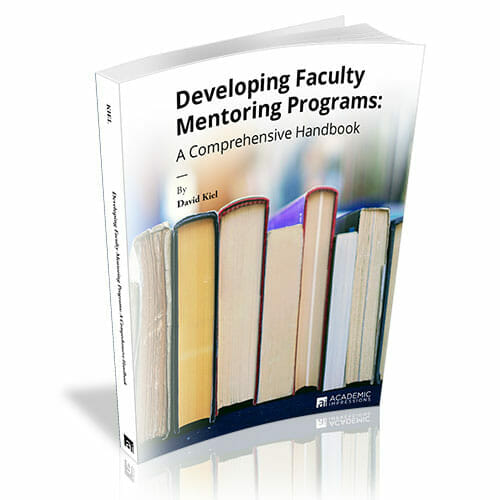
Formally defined, structured faculty mentoring is more critical now than ever – and not only for early career faculty but for faculty throughout their career. Expert David Kiel explains why this is the case and how we can improve faculty mentoring programs.
Often faculty members do not learn core skills in their graduate programs. While they may learn how to be good researchers, they often come to campus unequipped for the classroom and have even less experience in community service. In addition, without thoughtful guidance they may lack the ability to navigate promotion processes. As their careers progress, they may be asked to take on additional tasks for which they also have no preparation.
Consequently, it is critical to improve mentoring and faculty development programs at all levels of institutions of higher education. This article summarizes the reasons why this movement has become so widespread and provides directions for academic leaders who want to improve their efforts at retaining and developing their faculty, arguably their most important asset.
I will identify five reasons why well-defined faculty mentoring programs are becoming a “must have” feature of campus life. I also offer ten specific precepts that lay out the direction for positive change.
5 Reasons Why We Need Better Mentoring and Faculty Development Programs
1. Increasing diversity has added to the need for well-structured mentoring.
After WWII the US began a huge experiment in “higher education for all” that continues today. The GI Bill, the Higher Education Act of 1965, desegregation, immigration, the community college system, and Title IX brought successive waves of new types of students to post-secondary institutions. (1) Partly as a response to these events, demands for the faculty to diversify as well became ever more insistent. As more women and faculty members of color were hired beginning in the late 1960s and early 1970s, it eventually became clear that the informal mentoring system and the established norms of promotion and tenure were not going to work for all. White men who had informal mentors would get information and assistance that women and faculty members of color did not have access to. There was little appreciation for the demands of child rearing. There was evidence of implicit bias and evident gender, race, and other biases in selection and promotion. (2)
Generational differences have come into play as well. Younger baby boomers and Gen X faculty “have been vocal about wanting…more transparency and processes, more welcoming and supportive processes, more welcoming and supportive workplace/department, and more frequent and helpful feedback about progress.” (3)
Also, as teachers and scholars from other nations became US faculty members, it became clear that the styles of teaching, research, and student-faculty interactions they had learned might not fit with preferred US approaches. New concerns about gender identity and sexual orientation add other areas of complexity. As diversity increases, the university becomes a more “low context culture” where cues on how to succeed are less easily acquired from normal interactions and observations. So faculty need help in navigating that culture successfully. (4)
2. Social dynamics can be a barrier to getting help for new faculty members.
Personality and patterns of faculty interaction are also factors in skewing who gets help. Some talented people might derail in informal or poorly structured mentoring programs because they fail to seek help when they need it, in the mistaken view that this will compromise their independence. They may also fear to seek help from the senior faculty, who they think might evaluate or constrain them. On the other hand, potential mentors may be too busy with their own work to reach out to younger faculty and may not see that as their role or obligation. Or they may fear that their offers will be seen as interference. They may not have had effective mentors and may be unsure how to perform the role.
If you are a new minority faculty member, or a new female faculty member in an overwhelmingly male department, there is a chance you might feel quite isolated if someone did not reach out to you to help you become part of the group – and guide you through the tenure process. On the other hand, white male faculty may be uncomfortable in reaching out, because they don’t want to emphasize differences. So, there may be many factors that confound the informal mentoring system.
3. Increasing standard for productivity also adds to the need for structured mentoring.
Furthermore, as expectations for faculty grow ever higher, young faculty members, male and female, white and of color, have became more anxious about what is going to be demanded of them. National surveys show that early career faculty members are looking for more clarity, guidance, and collegiality. (5) In the competition for the best talent, having a reputation as a place where young faculty members “sink or swim” on their own is not a selling point.
4. Adding more non-tenure-track faculty also increases the need for mentoring programs.
In addition, as long serving, fixed-term, full-time faculty members become more numerous in the academy, they are playing increasingly important roles. They have not typically had focused career development or mentoring support, so there is a gap that becomes more obvious as formal programs are being put in place for the tenure track. More and more frequently, full-time non-tenure-track faculty are successfully making the claim that they should be integrated into the regular faculty and have clear paths for advancement, supported by mentoring and faculty development opportunities. (6)
5. There is a growing recognition of the need for mentoring for mid-career and beyond.
Once early career faculty members are promoted, there is often a drop off in motivation and careers can become stalled. Increasingly, forward thinking academic leaders are looking to mentoring and faculty development programs to forestall this “post-tenure slump” or to accelerate the way back to higher morale and productivity. They are looking to help avoid “stalled” mid-career faculty, and see great benefits from continuing to support senior faculty members in what are arguably their most productive years.
So for (at least) these five reasons, academic leaders have increasingly come to the conclusion that purely informal systems of mentoring are inherently unfair and ineffective. Some talented early career faculty will lose out, the institution will be subjected to costly unwanted turnover, and the reputation and morale of the unit could be damaged. On the other hand, providing better-structured and enhanced mentoring and faculty development programs is increasingly seen as a strategic institutional investment, and a competitive advantage in recruitment and retention
How Program Design Can Foster Good Mentoring: 10 Key Ideas
Academic leaders (e.g. chairs, deans, and provosts) cannot assure that a mentoring relationship will be of the classical life-long, career-informing, and deep-intellectual-connection variety, or that it will be a perfect fit for both the mentors and the mentees. (7) However, they can work to assure that mentoring programs are well structured and conform to evidence-based practices. (8) In my recent book I devote many pages to this issue; here, I will provide briefly ten precepts for assuring that programs are designed for success.
In an effective faculty mentoring program:
- The overall program goals are clear and relevant to the needs of the unit and the mentees.
- The roles of the mentors and mentees are well defined and written out.
- Linking of mentors and mentees is the result of a thoughtful process and is assigned to a specific leader.
- The program includes educational activities that are most needed by the mentees.
- Required and elective activities within the mentoring program are specified.
- There is effective communication about the program to mentees early on and to mentors about their roles and responsibilities.
- Special attention is devoted to ensure that the needs of diverse faculty mentees are addressed, including opportunities to talk about any concerns in a safe and supportive context. (9)
- There are adequate resources for program administration, whether the program serves a few faculty members a year in one unit or many faculty members across an institution.
- Each program must check from time to time to see: A) how well each mentoring relationship is doing and to address any serious problems, and B) how well the overall program is working and to make continuous improvements as needed. These duties of monitoring and evaluation are clearly assigned and well resourced.
- Once mentoring and faculty development efforts are well established for early career faculty, they should be systematically extended as appropriate to mid- and late career faculty, both tenured and fixed-term.
In Conclusion
In summary, the main reasons for investing in stronger mentoring and faculty development programs include:
- Faculty need more support because of the increasing demands and expectations for teaching, research, and service.
- Informal mentoring arrangements are likely to leave some faculty falling between the cracks; under-represented minority faculty—whom most departments are trying so hard to recruit and retain—are most at risk.
- Late Gen X and Gen Y faculty have higher expectations for transparency, support, and collegiality than the older “boomers” and their predecessors.
- There are increasing expectations that full-time, non-tenure-track faculty should have promotional paths, mentoring, and development opportunities.
- Failure to meet rising expectation for effective mentoring and support could result in costly faculty turnover.
- As institutions work to upgrade their mentoring and faculty development systems, institutions that are lagging may be at a competitive disadvantage in recruitment.
- Research shows that effective faculty mentoring improves faculty satisfaction, retention, research productivity, and student learning.
The benefits of improved faculty retention and productivity can be best achieved if mentoring and faculty development programs are aligned with the ten principles above. Then and only then can we have confidence that, as leaders, we are doing right by the faculty and strengthening the institution to best serve students and society.
David Kiel has spent the better part of the last two decades working in faculty development at the University of North Carolina at Chapel Hill and has advised leaders at many other universities and colleges on faculty development issues. He is the author of Developing Faculty Mentoring Programs, A Comprehensive Handbook, Academic Impressions, 2019. This article closely follows the argument in the introduction to the book.
About the Book
Notes
- For a good, brief overview of the history of changes in US college and university enrollment, see Louis Menand’s “College: The End of the Golden Age” in The New York Review of Books, Oct. 2001 Issue. Access at: http://www.nybooks.com/articles/2001/10/18/college-the-end-of-the-golden-age
- I think it’s fair to say this historical narrative is generally accepted. For research documenting the particular difficulties that women and faculty of color face, see Carnegie Mellon’s “Fostering a Mentoring Culture: A Guide for Department Heads,” Mark Kamlet Provost, Revised 2002. p.2. https://www.cmu.edu/teaching/resources/MentoringFaculty/MentoringGuideDepartmentHeads.pdf and Rachel Thomas’ “Exemplary Junior Faculty Mentoring Programs, WFF-Yale University, 2005, p. 15, citing documented issues at the University of Wisconsin: https://cpb-us-e1.wpmucdn.com/blogs.cornell.edu/dist/8/6767/files/2016/01/Exemplary-Junior-Faculty-Mentoring-Programs-105ab08.pdf
- Cathy Ann Trower, Success on the Tenure Track: Five Keys to Faculty Job Satisfaction, Johns Hopkins University Press, 2012, Baltimore, p. 23.
- There is more on this in Walter H. Gmelch and Jeffrey L. Buller’s Building Academic Leadership Capacity: A Guide to Best Practices, Jossey Bass, 2015, p. 159.
- See Cathy Ann Trower, Success on the Tenure Track: Five Keys to Faculty Job Satisfaction, Johns Hopkins University Press, 2012, Baltimore, p. 44-62.
- For one example of advocacy in this regard, see “The Imperative for Change: Understanding the Necessity of Changing Non-Tenure-Track Faculty Policies and Practices” by Adrianna Kezar, Daniel Maxey, and Lara Badke. This is a White Paper prepared as part of the Delphi Project, 2014. The Delphi Project is housed in the Pullias School of Education at the University of Southern California: https://pullias.usc.edu/delphi/
- What constitutes a good mentoring relationship in a classic sense is discussed in the book Good Mentoring: Fostering Excellent Practice in Higher Education, by Jeanne Nakamura and David J. Shernoff, Jossey Bass, John Wiley and Sons, 2009. See especially pages 219-265. Also, see the discussion of traditional mentoring in the VCU School of Medicine Faculty Mentoring Guide, Revised March 2002, by Dean Heber H. Newsome, and Associate Dean Carol H. Hampton, p 1-2 Visit https://medschool.vcu.edu/media/medschool/documents/fmguide.pdf
- Joselynn Fountain and Kathyrin E. Newcomer summarize the literature through 2012 in their 2016 article “Developing and Sustaining Effective Faculty Mentoring Programs.” Journal of Public Affairs Education, JPAE 22 (4), 483– 506. See especially pages 485 and 492.
- Kerry Ann Rockquemore provides a good primer for chairs on the issues that might arise for under-represented minority faculty in Inside Higher Ed: https://www.insidehighered.com/users/kerry-ann-rockquemore. See her essays:
- “Advice for Mentoring Underrepresented Senior Faculty Members.” Inside Higher Ed, 3/02/16.
- “Advice to a White Professor About Mentoring Scholars of Color.” Inside Higher Ed, 2/17/16.
- “How to Retain a Diverse Faculty.” Inside Higher Ed, 1/06/16.
Photo credit: The image at the top of this page is by Susan Yin on Unsplash.



